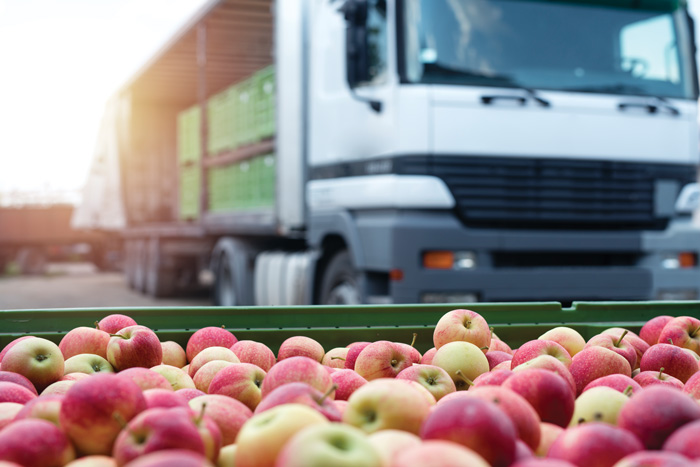
Building Supply Chain Resiliency
COVID upended the apple cart for food, beverage, and ingredient companies, and many anticipate permanent changes in sourcing and managing the flow of goods.
Article Content
Everyone remembers the Great Toilet Paper Shortage of March 2020. It turned out to be the first of many supply chain disruptions during the COVID-19 pandemic, which also included the supply chain for combating the disease itself—ranging from shortages of masks and personal protective equipment in the early months of COVID to an initially sluggish rollout of the vaccines.
The food, beverage, and ingredient industries certainly were not immune to these ills. The meat and poultry sectors, for example, were hard hit due to plant closures when coronavirus outbreaks rippled through their workforces. Last summer, RTI International cited loss of production capacity estimates among slaughter plants at 25% for beef and 43% for pork, according to The Washington Post, and 15% for chicken, according to Poultry World.
Supply chain vulnerabilities like these, laid bare during the COVID-19 pandemic, have prompted CPG companies and their ingredient suppliers to work at building more resiliency into the process by which they source products and manage inventories.
Some companies changed their philosophy from “just-in-time” to more of a “just-in-case” approach driven by shortages that emerged during the pandemic. Supply chains previously kept deliberately lean were “pumped up” with new suppliers. Many companies considered new approaches to risk management. And all of these moves have been supported by advanced digital technologies that aim to improve efficiency and forecasting ability.
To JP Frossard, consumer foods analyst for Rabobank, the onset of COVID underscored supply chain uncertainties that already had begun to build during the trade wars and renegotiations of treaties during the Trump Administration. “It was a wake-up call that you needed Plan Bs and Plan Cs,” he says. “We did see a lot of companies pivoting from one day to another.”
“We were forecasting significant change across the food system before COVID,” notes Rob Dongoski, agribusiness leader at Ernst & Young. “What COVID did was validated those things are going to happen and, in some cases, actually accelerated those shifts. ... Traceability, online grocery, click-and-collect, last-mile delivery—all got accelerated. That’s going to continue. It’s not going to snap back to where it was before.”
When COVID hit, panic buying required immediate supply chain adjustments due to the 20% increase in overall demand, says Tom Madrecki, vice president of supply chain for the Consumer Brands Association. That demand has moderated to less than a 10% boost overall compared with pre-COVID, but it’s still required ongoing investments in manufacturing and transportation capacity, he says.
COVID changed the mindset for potential CPG customers of Agricycle Global, which produces more than 100 ingredients sourced from micro-processor farms in Sub-Saharan Africa, and then aggregates them in centralized facilities, says Josh Shefner, founder and CEO. “They’re way more open to new ideas. That’s highly due to COVID. There weren’t many people aggregating smallholders in ingredient supply.”
The pandemic impacted countries’ openness to each other’s goods, says Paul Serra, president and head of global operations for Olam Food Ingredients. “There are always vulnerabilities in supply chain,” he explains. “COVID changed where those vulnerabilities were—country to country, sea or land freight—and it changed even within countries, how states were or were not working with each other. ... There were big changes at the macro level. We needed to be quick in adapting to the new ways trade was happening between countries and across borders.”
Rethinking Just-in-Time
The shortages of certain products and increased demand have led many CPG companies to conclude that the gold standard “just-in-time” supply chain model needed to morph to a “just-in-case” mindset that built up inventory and allowed greater margin for error.
Dongoski has seen the shift. “I’ve got to keep a little bit extra, just in case consumers want to hoard,” he says, describing the new mindset. “How do I fill that supply, just in case there’s a big disruption? How do I make sure I can fill my side of the value chain?”
Companies are concluding that while COVID is unprecedented, it’s not as much of a “black swan” event as originally thought, observes Madrecki. “The retailer is ... asking CPGs to hit performance metrics so retailers can get consumers to the front doors of e-commerce and keep pace with each other in a competitive landscape,” he says. “I don’t think the on-time mantra is changing entirely so much as it’s evolving to include more of a diversity of metrics.”
As a mostly made-to-order private-label manufacturer, Bergin Fruit and Nut has invested in a new distribution facility to handle just-in-case. Michael Finn, finance manager, explains, “We are now carrying inventory to ensure we can keep shelves full at the retailer level. That was a fundamental shift. The change on the inbound side has been vendor lead times—we have adjusted the lead time for procurements ... to ensure we’re meeting customer demand.”
Olam Food Ingredients does not believe that holding more inventory, in and of itself, is the solution to “just in case,” says Serra. “With our strong integration with customers and with farmers, we were able to put the two together and figure out, based on the environment, where we needed to add inventory to service our customers, without adding to every point in the process,” he says. “Where did we want to hold buffers? In the U.S. spices business, we tried to move as much into the United States as possible. ... Being able to respond when customers said, ‘My volume has gone up 40%,’ was critical to giving customers good service.”
Cargill also sees companies building more inventory, but not across the board. “Some customers are increasing inventories—or they are asking us to increase inventories—in a move to build more resiliency,” says Mark Ratcliffe, vice president of supply chain planning with the company. “We’re continuing to take a hard look at our network, ensuring we fully understand, at all times, the capabilities available at each location. ... We strategize how to manage different scenarios, so if a disruption happens at one location, we’re able to smoothly shift to other locations.
“Certainly, for items with longer lead times, customers are keeping reserve stock on hand,” Ratcliffe continues. “Where there is more capacity in the system, some customers may still opt for just-in-time delivery. At a minimum, however, companies are doing a very thoughtful evaluation of their inventory strategies. The big question they’re asking: ‘Is the working capital savings worth the risk of disruption in supply?’”
Ignacio Felix, partner at McKinsey & Co., has seen a huge transition in thinking on just-in-time. “You get a lot more speed in the supply chain,” he says. “Some food and beverage players are exploring centers in large cities to do the delivery to homes themselves. There’s lots of experimentation around new ways of making e-commerce work. This has been a positive trend for several years, but this past year it grew what it was expected to grow for the next 10 years.”
Deacom has been helping customers figure out what metrics they need to change in their software to execute the just-in-case strategy, according to Scott Deakins, chief operating officer. “We’re looking at safety days numbers, to make sure they have realistic numbers in case of a pandemic, or major shipping issues like the Suez Canal [blockage],” he says. “A lot of customers are moving toward diversifying their package or parcel carriers.”
Rob Bailey, founder and CEO of Backbone AI, says thinking has changed more in some categories than others. “For nonperishables, we’re seeing a reduction in the importance of just-in-time, versus the risk of stock-outs,” he says. “For perishables, we’re seeing a shift to more [risk-averseness] because of constantly changing customer needs. And a shift to making perishables less perishable.” The latter can be accomplished through careful cold-chain tracking to ensure longer shelf-life—keeping transport temperature lower for seafood, for example—and shifting to more refrigerated and frozen food displays, vis-à-vis room temperature.
Matt Schwartz, co-founder and CEO of Afresh, an artificial intelligence–powered replenishment platform for fresh grocery products, sees the degree of shift varying by inventory location. “At the store level, it is still financially optimal to run relatively lean and closer to just-in-time,” he says. “Higher up the supply chain, though, it’s become clear that having more inventory in the system is beneficial—think, long delays producing and distributing toilet paper and hand sanitizer. For fresh categories that see daily or near-daily replenishment, a just-in-time model can still maximize freshness and in-stock rate while reducing shrink.”
Time to Pump It Up?
Are CPG companies adding suppliers in response to COVID disruptions? Madrecki sees them reevaluating their array of sourcing, although in some verticals, there aren’t many options. “You have a degree of sourcing flexibility,” he says. “But at the end of the day, all of your latex gloves come from one or two suppliers. You thought you had different suppliers, but it turns out they all source from the same factory in Malaysia.”
Dongoski says the bare shelves in some sections of the supermarket were shocking to American consumers and inevitably has prompted companies to reexamine their supplier networks. “I can’t get my filet mignon—I’m distraught,” he says. “Groceries and QSRs are thinking about, ‘How do I source?’ I don’t see them adding suppliers so much as picking and segmenting suppliers. ‘Who are my go-to suppliers? Maybe I need to invest. Maybe I need to verticalize.’”
Bergin Fruit and Nut can’t necessarily diversify relationships because formulations are not the same from vendor to vendor. “We have diversified transportation relationships to ensure we have alternatives,” Finn says. “We have a number of products that are imported. That’s been a challenge.”
Agricycle has benefited from CPGs wanting to add suppliers, says Shefner. “We’ve seen that in some of our larger buyers, and even in the startups, the fast-growing small and medium-sized companies,” he notes. “They have gone from getting the cheapest things that meet their standards to wanting to make sure they don’t get screwed over. I have seen people spending more money to have more resilient supply chains.”
Olam Food Ingredients works to forge deep relationships with suppliers and hasn’t necessarily found that adding suppliers reduces risks, especially during a pandemic, according to Serra. “If a whole region is affected, you could have five different suppliers, but they’re all suffering the same macro issues. ... Customers and suppliers are starting to get more integrated in the way we work with each other and share information. COVID has accelerated the need for that.”
Ratcliffe says Cargill sees both a cost and a risk to broadening a company’s network. “It becomes more difficult to maintain consistent quality, and you have more contracts to manage,” he says. “That said, if a company is in a single-source agreement, they are likely looking to add one or two alternate suppliers. In truth, single-source agreements were already in decline before COVID. The disruptions caused by the pandemic only accelerated that trend.”
SWARM Engineering has seen companies adding suppliers while also thinking more strategically about the universe they’re tapping into, says Anthony Howcroft, CEO and co-founder. “Companies are using more carriers because they can’t always get the service from the existing ones,” he notes. “However, there has been a trend to look at the balance of risks—where are our key suppliers? If one airport or region was closed, where could we source this from?”
Companies testify to Rabobank that they are always looking to add suppliers, Frossard says, but the variety of SKUs slimmed during COVID. “In the past five years, bakery companies have launched multigrain and tried to grow sales with new stuff. Then the pandemic arrived, and everybody wanted to buy white bread. They’ve had the opportunity to say, ‘I don’t need to have 40 products.’ This, by definition, is going to leave the supply chain simpler.”
Reducing Risk
To better manage risks in the wake of the pandemic, companies are considering new ways of doing resiliency testing, observes Madrecki. “A number of CPG companies are modeling their own operations and running them through different scenarios to see where there are breaking points, [and] where there are nodes within a system that a lot of things funnel through, and therefore are potentially more vulnerable,” he says. “If everything flows through this one dock, and if that goes down, the West Coast won’t get chicken.”
Randy Jagt, partner at Deloitte and future of food lead, observes that at least a couple of his clients are investing heavily in risk management. “One put systems in place with a risk rating—what’s the level of dependency, and how risky is it to deal with this supplier?” he says. “It still requires a due diligence process to have that level of insight.”
“Many agribusiness companies are deploying tools to make sure they protect their business,” says Sean Lestiboudois, Deloitte senior food supply chain strategy consultant. “If they don’t do it, very soon they will lose business because they can’t provide the necessary traceability and transparency to upstream players that are demanding it.”
Olam hasn’t seen the already rigorous process of risk management itself change, Serra says. “What was accelerated was the speed at which we needed to make decisions,” he notes. “Finding a fast and effective way for information to flow was critical in the COVID world. Advancements in technology, video, AI, machine learning, and the steps forward being made in that space have enabled us to act faster.”
The Impact of Technology
AI and machine learning will help enormously in prying open the black box of demand forecasting through analytical tools, believes the Consumer Brands Association’s Madrecki. “Demand is more and more knowable,” he says. “It’s ... to get an insight to the consumer—to be able to know more, to predict, and coordinate with retailers on what’s going to be available.”
Madrecki imagines that future supply chain networks will be highly automated and that CPGs will need to know more about what’s happening at any given point along the supply chain. “You know a truck is about to arrive, the information is relayed to the appropriate people, and he knows which dock to go to, driving toward efficiency where you don’t have people waiting,” he says.
Bergin Fruit and Nut has found its partnership with software provider Deacom invaluable, helping with integration of inventory, production, and procurement datasets and bringing them into real-time, so everyone is keeping current hour by hour. “It’s been critical to keep those individual department managers together, with no one in a silo,” Finn says. “We never thought we would go into the COVID environment one month after we launched the system. I would have been frustrated had we not had these tools to get good information in front of the executive and sales team.”
Digital technology has helped startups like Agricycle build a level of traceability, according to Shefner. “We try to go as far as we possibly can with it—being able to trace back to that exact farm, and that exact batch,” he says. “On the consumer side, which is the key for us, it’s about showing not just traceability but transparency.”
Olam has started to use AI for its demand forecasting capacity, trying to correlate and predict both the outcome of crops and demand for different products, Serra says. “How factories best deal with incoming inputs is something that’s always been done at an operational and human level,” he says. “Now, we’re using AI and machine learning to correlate what the most efficient set points are, for the entire process, and we’re getting fantastic results. You need the horsepower and data crunch of machine learning to get at that.”
Cargill has been using digital technologies in supply and demand forecasting for quite some time, observes Ratcliffe. “This allows companies to utilize causal modeling, considering other external factors beyond historical demand information, for better forecasts,” he explains. “In turn, better forecasts allow companies to be more efficient throughout their entire supply chain. These advanced technologies are the talk of the supply chain world.”
SWARM Engineering has seen a huge increase in activity along with a shift in AI’s use cases from logistics efficiency to areas like demand and supply balancing, or sales or supply forecasting. “These processes have always been hard, but in a time of disruption, they step up in complexity,” Howcroft says. “We’ve seen great results from organizations taking a cognitive approach—that is, not relying purely on AI, but augmenting human expertise with the latest algorithms, to get an active partnership between planners and AI systems.”
“We haven’t scratched the surface of what [AI and machine learning] can mean for inventories and production planning,” says Dongoski of Ernst & Young. “If you think about supply chain in three tranches—farm-to-factory, inside the factory, and factory-to-consumer—you will see different applications accordingly.”
Many CPG companies still have some distance to travel in enabling AI and machine learning to fully benefit their supply chains, according to Lonneke Knipscheer, supply chain strategy partner and leader of supply chain consumer products industry for Deloitte. “There’s a lot of information on things that happen outside the four walls of an organization that benefit the supply chain,” she says. “Using that information more effectively in planning and product design is a big step forward. Not everybody, by far, is there, other than in their minds and their wishes.”
Felix believes the use of AI and machine learning in supply chain has seen 10 years of acceleration in the past year, and that 95% of food, beverage, and ingredient companies at least have it on their agenda. “In the last eight months, it went from, ‘I’m considering it,’ to ‘I’m trying something,’ to ‘Everybody is trying something,’” he says.

















